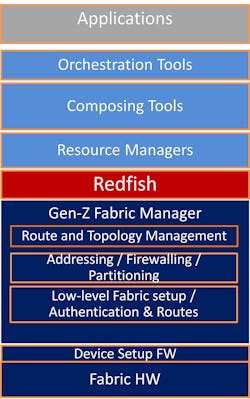Gen-Z Open Memory Fabric: Paving the Way to a Universal Fabric Manager
>> Electronic Design Resources
.. >> Library: Article Series
.. .. >> Series Topic: System Design
.. .. .. >> Gen-Z: Opening Up the Data Center
What you'll learn:
- How Gen-Z fabric helps streamline the data center.
- Details on the recently released Gen-Z Fabric Management Specification 1.0.
- Gen-Z's alignment with the DMTF Redfish model.
In a previous article, “What is Gen-Z? An Overview of Gen-Z Memory-Semantic Fabric Architecture,” we learned that the Gen-Z Consortium is an industry organization developing an open-systems, fabric-based architecture designed to deliver high-speed, low-latency, secure access to data and devices. Here, we’ll further explore the intricacies of the fabric.
About Gen-Z Fabric
Gen-Z defines a multi-host memory semantic fabric architecture for composable and shared resources. A Gen-Z fabric can tie hyperconverged platforms together; it can compose disaggregated resources into virtual platforms; it can expand a simple compute node with additional fabric-based memory, storage, networking, or accelerators; and it’s able to connect in any topology.
Ecosystem Benefits of Gen-Z Fabric Architecture
Gen-Z fabric provides several features and benefits to the data-center environment, including:
- Automated congestion management for predictable quality of service (QoS)
- End-to-end retry for reliable transport
- Multiple fabric managers for scaling
- Standards for interoperability of hardware and software
- Memory semantics for support of byte-addressable load/store transactions
Gen-Z fabric is intended to be the backbone of a fabric for runtime composable systems. It allows solution providers to combine disaggregated compute, storage, and even memory resources to create systems optimized to run a specific application. Gen-Z fabric is designed to scale from a single enclosure to an entire data center. As a result, it enables composition of total solutions of any size.
Managing such a scalable and flexible infrastructure fabric becomes a non-trivial task.
Gen-Z Fabric Management
The Gen-Z Consortium Software and Management Work Group developed the Gen-Z fabric-management architecture and recently released Gen-Z Fabric Management Specification 1.0 (download at genzconsortium.org/specifications). This document establishes a general view of the Gen-Z fabric’s management stack from the hardware layers up through the orchestration tool layers and defines the hierarchy of the various manager services.
It also defines the role of Gen-Z fabric managers within the hierarchy as well as the general policies and workflows used by the fabric managers to execute their roles. Since the Gen-Z Fabric Management Specification itself is focused on the fabric-management layers, the specification outlines the nature of interfaces and APIs between Gen-Z fabric managers in addition to the layers above and below in the overall stack, and bases these interfaces on existing standards.
Thus, the Gen-Z Consortium Software and Management Work Group adopted the DMTF Redfish model to be the northbound interface and configuration language (Fig. 1).
Redfish is an open-standard model of a fabric and its resources. Gen-Z aligns with the Redfish model where resources can include switches and their ports, as well as endpoints along with all associated routing tables and permissions, plus the connections between endpoints, which establish communications. The protocol allows clients to control host, fabric, and endpoint resources and enables fabric-specific providers to program a common set of APIs. This approach leverages proven, trusted methodologies and simplifies integration with pre-existing management systems that use the Redfish DMTF structure.
These resources are all modeled in a Redfish resource tree using a JSON-based schema that’s managed and maintained by the Gen-Z fabric manager. This schema is exported as a Redfish service to the upper-layer clients, such as composability managers and resource managers which translate user intent into functioning infrastructure by requesting changes to the fabric model.
Gen-Z Micro Development Kits for Fabric Testing
Gen-Z Micro Development Kits are now available for purchase by members of the Gen-Z Consortium. The Micro Development Kit consists of IP, devices, and components from Gen-Z Consortium member companies, and includes an Arm-based Linux host card that can perform load/store native Gen-Z accesses to a Gen-Z Memory Module (ZMM) connected with a backplane and cable.
According to the Consortium, the Gen-Z Micro Development Kit is the smallest, simplest hardware platform that allows for the development and testing of Gen-Z in-band management and fabric manager software, as well as Gen-Z memory-centric computing applications that use disaggregated memory (Fig. 2). For Gen-Z endpoint developers, it can also be utilized to develop device drivers.
Open Standards Solving Complex Problems
Gen-Z fabric architecture brings a multi-vendor, multi-tenant, highly scalable, memory-semantic, composable fabric to the data center, cloud installation, and racks of servers.
Artificial intelligence, machine learning, and neural networks are revolutionizing the scope and type of challenges that developers are beginning to confront. But other obstacles don't require complex algorithms as a solution—they just need larger and faster memory solutions with the ability to access vast datasets without transferring the data from one point to another. It’s called memory-centric computing, and it’s at the heart of what Gen-Z fabric is able to accomplish. However, as stated before, the management of such a flexible fabric requires innovation, too.
OpenFabrics Manager Framework
In addition to the work with DMTF, the Gen-Z Consortium announced a Memorandum of Understanding (MoU) with the OpenFabrics Alliance (OFA) earlier this year to advance the industry standardization of open-source fabric management. As a result, OFA recently created a work group to define an OpenFabrics Manager Framework to be built on the concepts of Redfish, with the intention of using Gen-Z as a strawman target for the first fabric manager plugin. The Gen-Z Fabric Management Specification 1.0 is a blueprint for a universal fabric manager provider.
As an open standard, Gen-Z fabric management is fertile ground for innovation, so dig in and find a clever way to make a contribution—perhaps as a member of the OFA’s new work group.
Russ Herrell is a System Architect at Hewlett-Packard Enterprise (HPE), Duane Voth is Senior Principal Engineering Technologist - Office of the CTO at Dell EMC Server Solutions, and Tim Symons is Associate Technical Fellow at Microchip Technology.


